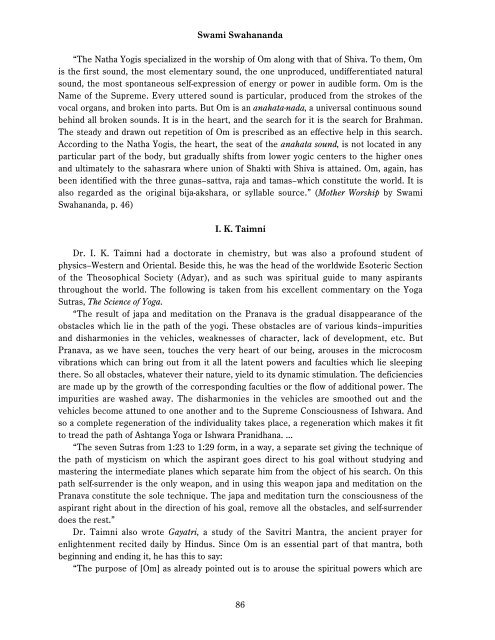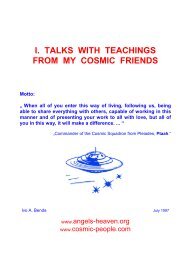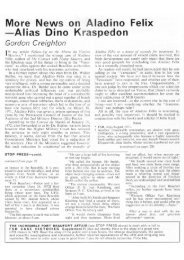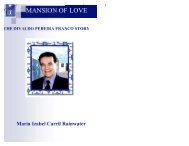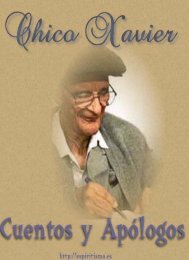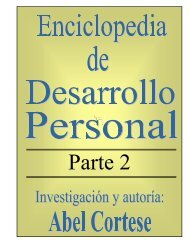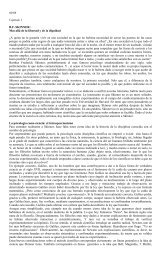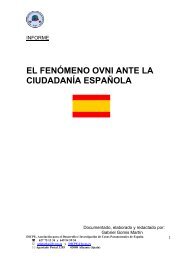The Word That is God
The Word That is God
The Word That is God
You also want an ePaper? Increase the reach of your titles
YUMPU automatically turns print PDFs into web optimized ePapers that Google loves.
Swami Swahananda<br />
“<strong>The</strong> Natha Yog<strong>is</strong> specialized in the worship of Om along with that of Shiva. To them, Om<br />
<strong>is</strong> the first sound, the most elementary sound, the one unproduced, undifferentiated natural<br />
sound, the most spontaneous self-expression of energy or power in audible form. Om <strong>is</strong> the<br />
Name of the Supreme. Every uttered sound <strong>is</strong> particular, produced from the strokes of the<br />
vocal organs, and broken into parts. But Om <strong>is</strong> an anahata-nada, a universal continuous sound<br />
behind all broken sounds. It <strong>is</strong> in the heart, and the search for it <strong>is</strong> the search for Brahman.<br />
<strong>The</strong> steady and drawn out repetition of Om <strong>is</strong> prescribed as an effective help in th<strong>is</strong> search.<br />
According to the Natha Yog<strong>is</strong>, the heart, the seat of the anahata sound, <strong>is</strong> not located in any<br />
particular part of the body, but gradually shifts from lower yogic centers to the higher ones<br />
and ultimately to the sahasrara where union of Shakti with Shiva <strong>is</strong> attained. Om, again, has<br />
been identified with the three gunas–sattva, raja and tamas–which constitute the world. It <strong>is</strong><br />
also regarded as the original bija-akshara, or syllable source.” (Mother Worship by Swami<br />
Swahananda, p. 46)<br />
I. K. Taimni<br />
Dr. I. K. Taimni had a doctorate in chem<strong>is</strong>try, but was also a profound student of<br />
physics–Western and Oriental. Beside th<strong>is</strong>, he was the head of the worldwide Esoteric Section<br />
of the <strong>The</strong>osophical Society (Adyar), and as such was spiritual guide to many aspirants<br />
throughout the world. <strong>The</strong> following <strong>is</strong> taken from h<strong>is</strong> excellent commentary on the Yoga<br />
Sutras, <strong>The</strong> Science of Yoga.<br />
“<strong>The</strong> result of japa and meditation on the Pranava <strong>is</strong> the gradual d<strong>is</strong>appearance of the<br />
obstacles which lie in the path of the yogi. <strong>The</strong>se obstacles are of various kinds–impurities<br />
and d<strong>is</strong>harmonies in the vehicles, weaknesses of character, lack of development, etc. But<br />
Pranava, as we have seen, touches the very heart of our being, arouses in the microcosm<br />
vibrations which can bring out from it all the latent powers and faculties which lie sleeping<br />
there. So all obstacles, whatever their nature, yield to its dynamic stimulation. <strong>The</strong> deficiencies<br />
are made up by the growth of the corresponding faculties or the flow of additional power. <strong>The</strong><br />
impurities are washed away. <strong>The</strong> d<strong>is</strong>harmonies in the vehicles are smoothed out and the<br />
vehicles become attuned to one another and to the Supreme Consciousness of Ishwara. And<br />
so a complete regeneration of the individuality takes place, a regeneration which makes it fit<br />
to tread the path of Ashtanga Yoga or Ishwara Pranidhana. …<br />
“<strong>The</strong> seven Sutras from 1:23 to 1:29 form, in a way, a separate set giving the technique of<br />
the path of mystic<strong>is</strong>m on which the aspirant goes direct to h<strong>is</strong> goal without studying and<br />
mastering the intermediate planes which separate him from the object of h<strong>is</strong> search. On th<strong>is</strong><br />
path self-surrender <strong>is</strong> the only weapon, and in using th<strong>is</strong> weapon japa and meditation on the<br />
Pranava constitute the sole technique. <strong>The</strong> japa and meditation turn the consciousness of the<br />
aspirant right about in the direction of h<strong>is</strong> goal, remove all the obstacles, and self-surrender<br />
does the rest.”<br />
Dr. Taimni also wrote Gayatri, a study of the Savitri Mantra, the ancient prayer for<br />
enlightenment recited daily by Hindus. Since Om <strong>is</strong> an essential part of that mantra, both<br />
beginning and ending it, he has th<strong>is</strong> to say:<br />
“<strong>The</strong> purpose of [Om] as already pointed out <strong>is</strong> to arouse the spiritual powers which are<br />
86


